
Liliane Lijn. Arise Alive, exhibition view, Haus der Kunst, München, 2024. Photo: Maximilian Geuter.
Haus der Kunst, Munich
5 April – 22 September 2024
by BRONAĊ FERRAN
Ethereal and yet material, filled with captivating points of light and shadow, and with a prismatic interplay between early and later titles, a new large-scale exhibition of works by Liliane Lijn at the Haus der Kunst in Munich reveals the integral coherence of her richly layered oeuvre. Walking around the beautifully designed and lit rooms, curated by Emma Enderby with Teresa Retzer, I gain access for the first time to a sense of a comprehensive overview that links different angles of Lijn’s practice together.
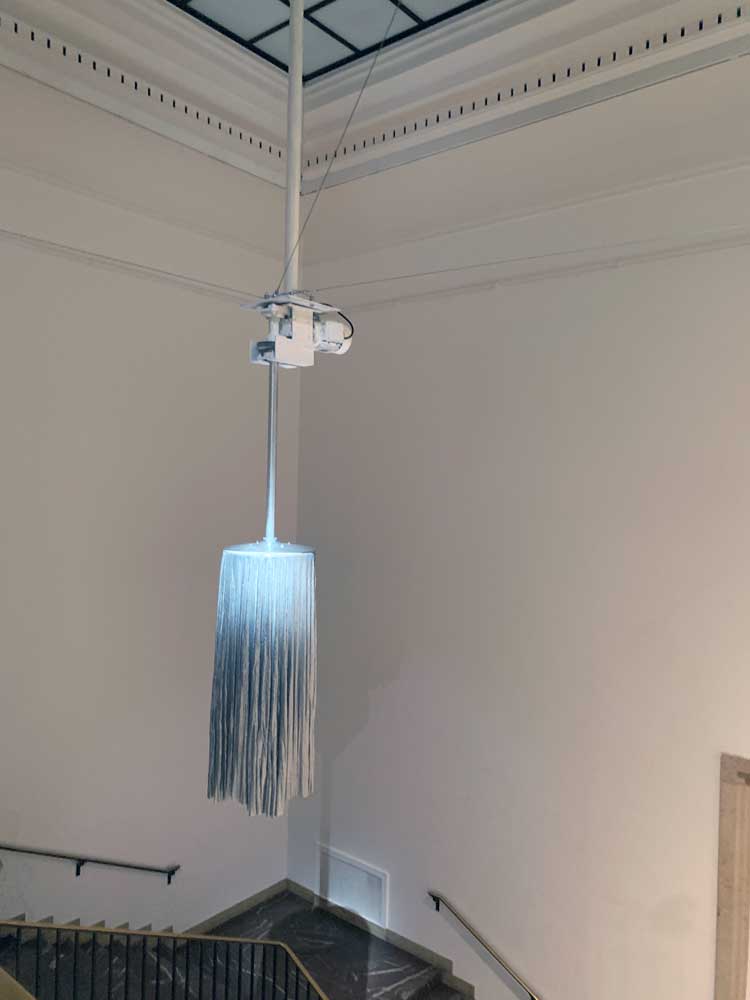
Liliane Lijn. Shimmering, 2024, installation view, Haus der Kunst, München, 2024. Photo: Bronac Ferran.
Beginning with Shimmering (2024), a skirt made from woven aluminium threads and LEDs that hangs inert in the entrance staircase, then rises at occasional intervals to open and spin – like a whirling dervish welcoming us to the exhibition – the show invites us to reflect on the life of forms behind seemingly inanimate surfaces, made visible by this pioneering artist by modes of transmutational transformation. As we proceed from the opening gallery, where an array of translucent, dynamic, kinetic, Perspex, wood and metal works are assembled, accompanied by photographs, crayon drawings and delicately linear and soft-hued works on paper, into the range of other spaces, we move also through time, from the late 1950s to the late 80s, as a passage during which – as Lijn observed in an opening talk – her work developed much like a tree does from its root to unfolding branches.
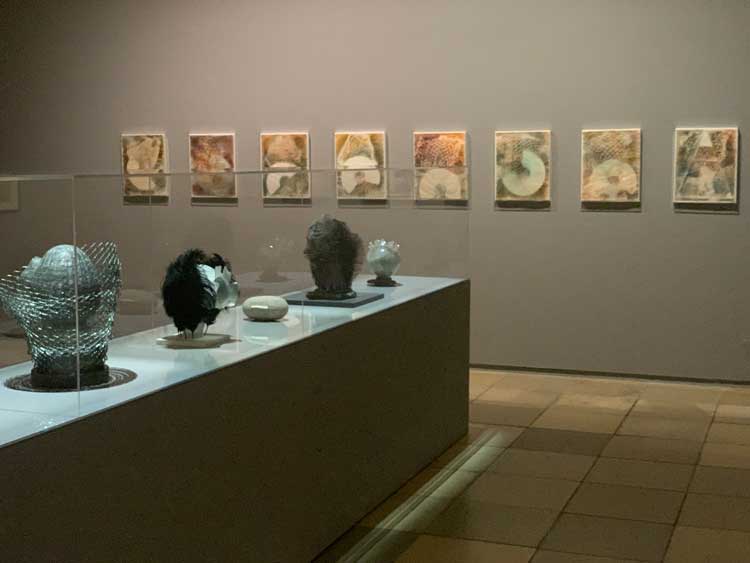
Liliane Lijn. Arise Alive, exhibition view, Haus der Kunst, München, 2024. Photo: Bronac Ferran.
As a venue, opened in 1937 as a cultural flagship for National Socialism, the Haus der Kunst is an exceptional context for the display of a lifetime of works made by Lijn, the Jewish-born child of a family that fled Europe on the last boat from Antwerp to New York in 1939. Commissioned on the instructions of Hitler to house and promote anti-modernist art in Germany, after the war the museum swiftly became a powerhouse of avant-garde and innovative art and architectural display and exhibition. This tradition has continued with various artist-led interventions into the cultural and historical context and fabric of the building since the mid-90s: the second invited artist, in 1999, was Gustav Metzger.
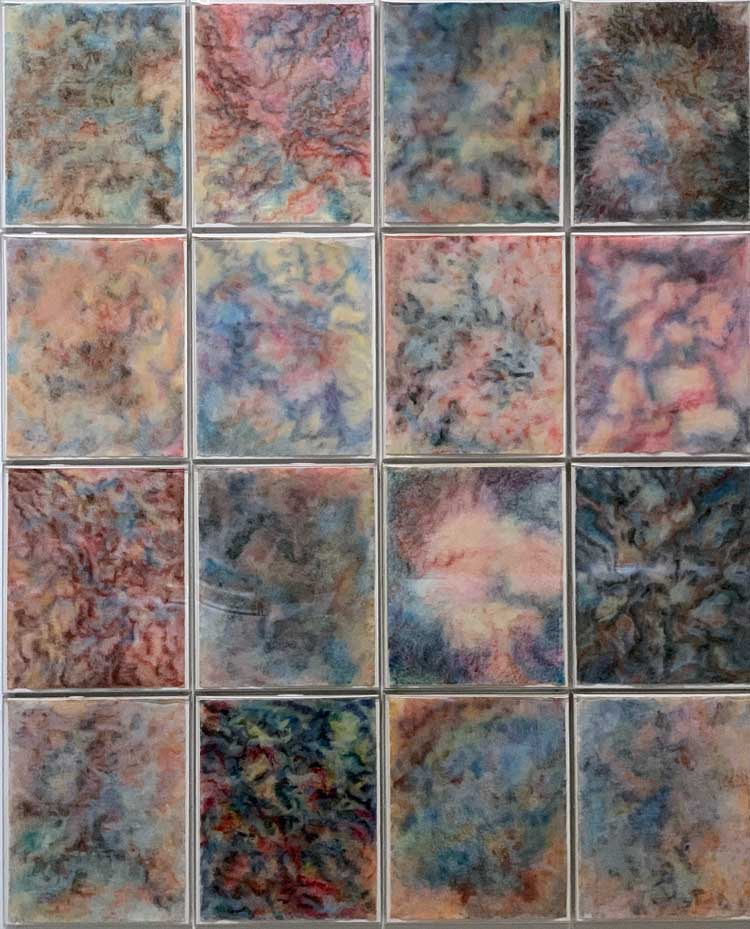
Liliane Lijn. Windows (Starskins), 1980. Soft pastel on hand pressed paper. Courtesy of Nicoletta Fiorucci Collection. Exhibition view, Haus der Kunst, München, 2024. Photo: Bronac Ferran.
Under its current artistic director, Dr Andrea Lissoni, who first encountered Lijn’s work when previously working at Tate Modern, the emphasis of the Haus der Kunst’s programme is on “transdisciplinary approaches, transnational outlooks, canon re-evaluations and intergenerational innovators” as well as a “commitment to live and live-ness in a growing digital world”, working in particular this year with important female artists where “the building becomes a stage for their choreographies” and is transformed “into a new living organism” from its architecturally imposing outside facade into the internal long-walled, high ceilinged spaces.1 The title of Lijn’s exhibition, Arise Alive, a phrase from one of the finest poem-cones that Lijn made when living in Greece in 1965, fits ideally into this vision.

Liliane Lijn. Poemkoan=D=4= Open=Apollinaire, 1968. Exhibition view, Haus der Kunst, München, 2024. Photo: Bronac Ferran.
As we proceed through the various spaces, some dramatically lit to build a sense of theatrical register, Lijn’s multisensory and philosophical pursuit of interconnections between the linguistic and non-linguistic, the material and immaterial, the cognitive and the perceptual, the linear and non-linear, plastic and natural, the spiritual and the scientific is transmitted effortlessly, as if her works were made for this context. From the deceptively subtle installation in the entrance staircase to a stunningly powerful tableau at the exit, the myriad ways in which Lijn has distilled and perfected the art of conjunctive juxtapositions, where patterns of a seemingly given duality shift towards non-dualistic conceptions through movement, are brought into curatorial focus.
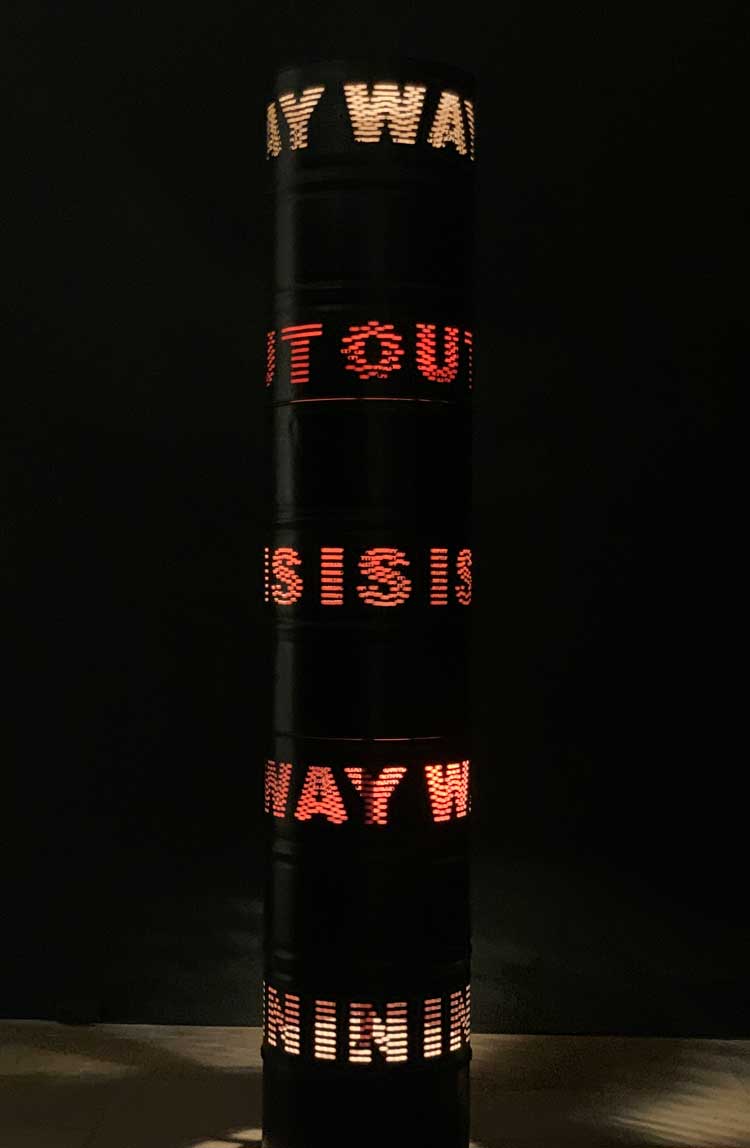
Liliane Lijn. Way Out Is Way In, 2009. Exhibition view, Haus der Kunst, München, 2024. Photo: Bronac Ferran.
So, too, across the range of works presented, from kinetic light pieces that turn in colourful lines to paper-based works featuring electronic symbols made from Letraset, from collaged photographs imagining hanging gardens along Manhattan skylines to the powerful shadows cast by Lijn’s early cuttings into Perspex in the opening years of the 60s, this exhibition encourages us to revel in Lijn’s ability to reveal the poetic within the industrial. It provides new insights into her artistic vision as an alchemical force of perceptual and, indeed, cognitive transformation.
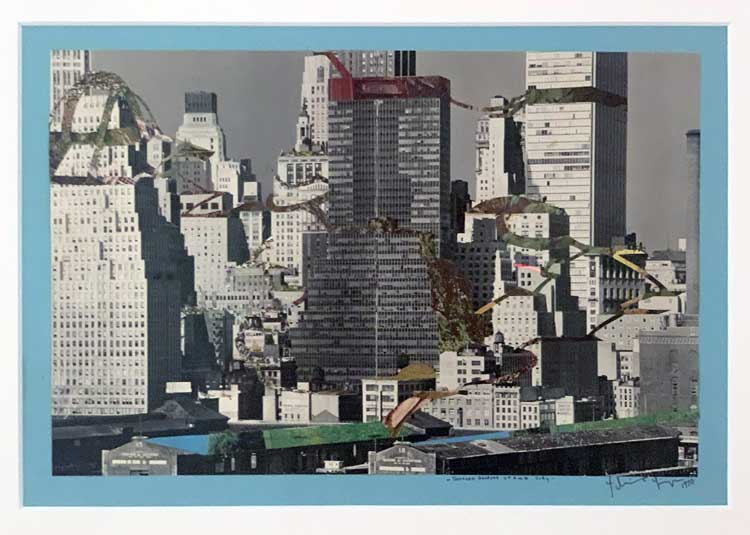
Liliane Lijn. Terraced Gardens of Rock City, 1970. Exhibition view, Haus der Kunst, München, 2024. Photo: Bronac Ferran.
Lijn also described the extended process of experimentation with systems of movement and materials that occurred before she finally got the “skirt” to unfold as she hoped, out from an inner vortex. We can see this, moreover, as a metaphor for the characteristic turns in much of what she has produced. In her introductory talk, Lijn noted in an amused tone her realisation along the way that “everything spins”. Indeed, what comes fully into focus within this timely exhibition is the long-term process of research and experimentation that underlies much of what she does that then is made visible in forms that appear perfectly complete, their reality in the world detached from the preliminary processes, achieving in a true sense a life of their own. Crucial to the curatorial approach in this exhibition, moreover, is the presence almost throughout of a sequence of deft and sensitive line drawings and multicoloured works and sketches on paper that reveal a rather lyrical sensibility underlying Lijn’s exploration of new materials. One of her best-known series of the 60s, Liquid Reflections (1968), eminently conveys the balancing of a lyrical combining of spheres and circles and of Perspex, light and water. This is exemplary of what I think of as poetic engineering.
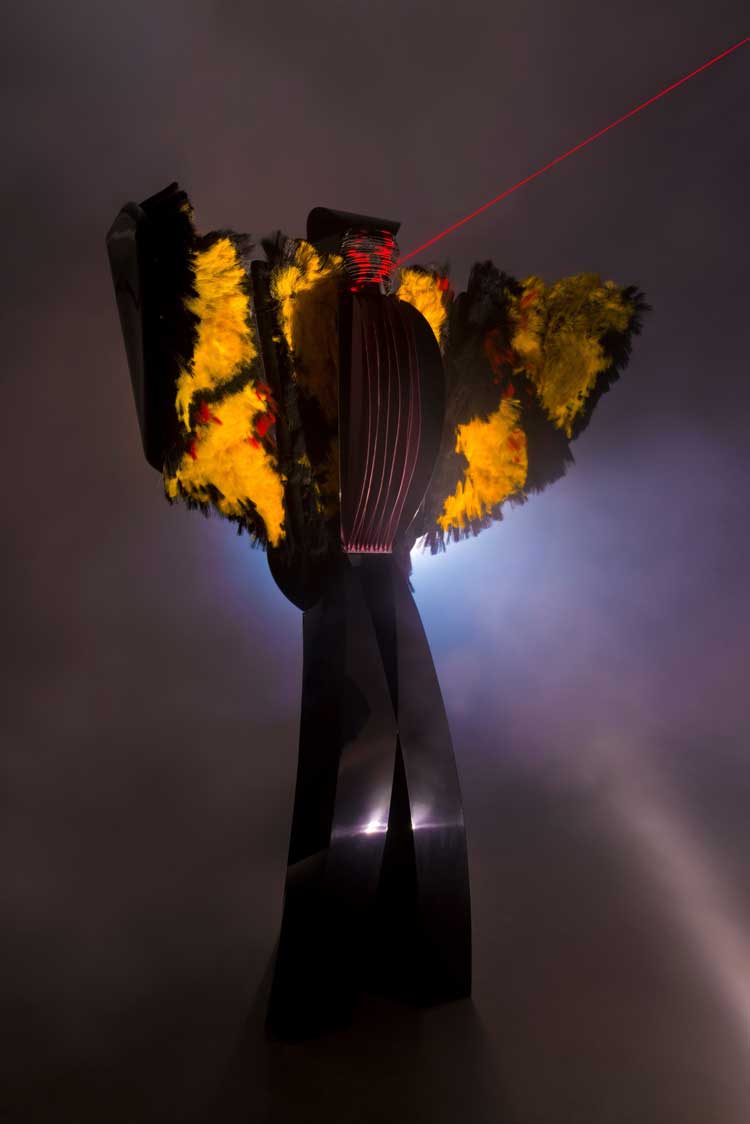
Liliane Lijn. Conjunction of Opposites: Woman of War, 1986. Painted steel and aluminium, synthetic fibres, glass prism, aluminium mesh, audio system, 5 milliwatt helium laser, smoke machine, computer. Courtesy Liliane Lijn and Rodeo, London / Piraeus.
While Lijn is a figure as important to postwar interdisciplinary art practices as Barbara Hepworth was to prewar sculpture or Bridget Riley to op-art tendencies, Lijn ’s pathfinding processes and technological feminism have only recently received wider critical recognition and broader audiences beyond the niche domains in which her visionary practice has long been celebrated. This was amplified in 2022 with the inclusion of a series of “humanoid sculptures”, in which Lijn “imagined a futuristic and ambiguous female form – part machine, part animal, and plant”, at the Venice Biennale, which brought her work to the attention of a new generation of curators and audiences.2 At Art Basel, meanwhile, in 2019, two powerful works, Woman of War (1986) and Lady of the Wild Things (1983) – the combination of which she has named “Conjunction of Opposites” – “well ahead of their time: using pioneering technologies, they also explored binary notions of gender, establishing femininity as a fluid cosmic fact” were presented by Lijn’s commercial gallery, Rodeo.3 This double installation along with the related piece, Electric Bride (1989), an environmentally reactive, mica-layered creation housed in a metal cage, accompanied by a relatively cryptic soundtrack, provides a fitting crescendo to this current exhibition.
In her opening talk, Lijn talked about Woman of War, which she made in 1986, having heard mediumistically in 1983 the incantatory melody and song that accompanies it. Her current speculative perception is that the piece might constitute a warning, by which she was implicitly referencing the current precarious geo-political and ecological state of the planet. In turn, the long-term framing of this exhibition allows us to recall the equally precarious stage of Lijn’s own professional emergence, as an artist who came of age along with the height of the cold war tensions that simultaneously threatened world annihilation and fuelled a race into cosmic space. For those artists and writers of Lijn’s generation who were living, as she did for a time, in hotels on the Left Bank in Paris, this was the beginning of an electronic revolution when the language and form of art and poetry was being opened up to reinvention. Lijn was a major figure within this scenario. In 1964, in England, the leading theorist of concrete and visual poetry in Britain, Dom Sylvester Houédard acknowledged Lijn as the first person to make electrically based poem machines. We can find a wonderful selection of these together within this exhibition. Due to transfer in November to Mumok (Museum moderner kunst Stiftung Ludwig), as co-organising partners and then, in 2025, to Tate St, Ives, which has also now become a collaborating venue, this exhibition is bringing considerably overdue historical attention to Lijn’s capacity to bridge the human and the technological in elegant and affective fashion.
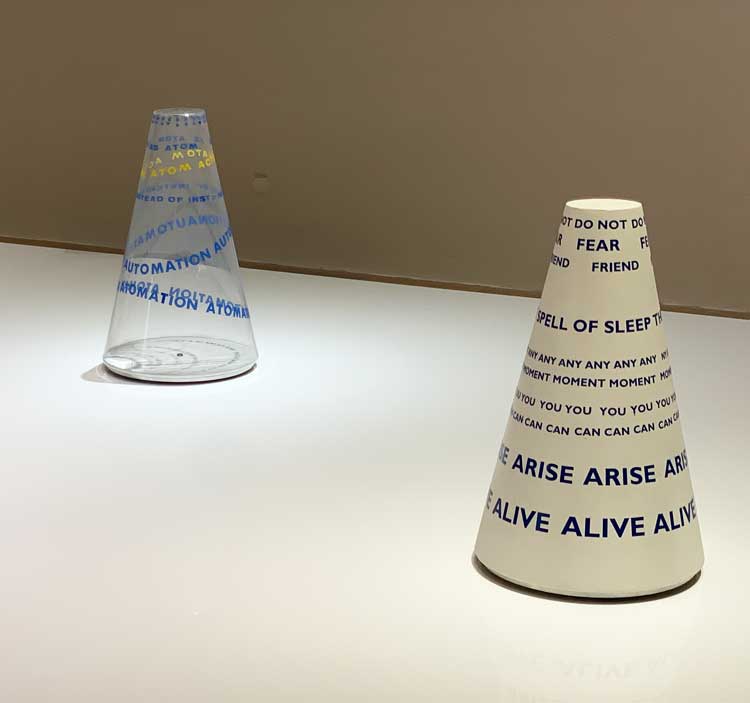
Liliane Lijn. Act as Atom, 1966 (left); Arise Alive, 1965 (right). Exhibition view, Haus der Kunst, München, 2024. Photo: Bronac Ferran.
As a long-term admirer of the luminous technological poetic present in her works of the 60s and early 70s, this exhibition has opened my eyes to a wider range of her creations, from the expressiveness of her earliest work on display – aptly named The Beginning” (1959), made with crayons and ink on paper, that Lijn recalls revealing to her the existence of a “cosmos inside” her that the work brought to light, along with “a vocabulary coming to recognise itself” that she was discovering in the act of making. This becomes a clear indication in retrospect of the entwining of Lijn’s artistic sensibility – and, indeed, self-identity as an artist – with the act of production with the material then also acting as a medium through which and from which her reality in this sense found expression. We might also look closely at the exquisite 1959 Fire Drawings series (Starspace 1-8) and Fire Lines (1960) composed when she was aged 20 and 21, using her own invented technique of melting “Teflon sticks” on to paper and Plexiglas. The underlying biological impetus and elemental expressiveness that can be discerned in closer looking at these early “actions” of using a primary element – fire –was swiftly followed by Lijn’s use of acid and cuts using a saw on Perspex during a period in New York from 1961-62; such tendencies reveal, too, her place within a creative destructive lineage, as a trajectory that deserves closer attention within the critical reappraisal of Lijn’s contemporary importance, that deserves to follow on from this not-to-be-missed exhibition.
References
1. For more information see the Haus der Kunst website here.
2. This is an excerpt from the Venice Biennale 2022 website, here.
3. This is described further here.
• Liliane Lijn: Arise Alive will be at Mumok, Vienna, from 15 November 2024 to 4 May 2025 and then at Tate St Ives from May to October 2025 (exact dates to be confirmed).